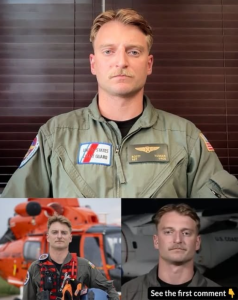
🌊 1. Context: A Nightmare Unfolds in the Hill Country
On July 4, 2025, Central Texas—particularly Kerr County—was struck by a sudden, devastating flash flood. A mesoscale convective vortex, fueled by remnants of Tropical Storm Barry, dumped intense rainfall in the region. Around 6.5 inches fell in just three hours, triggering flash flood emergencies. The Guadalupe River surged dramatically: at Hunt, it shot up by nearly 26 feet in 45 minutes and crested over 37 feet—levels unseen in a century
The deluge reshaped the landscape: cabins, bridges, and campgrounds vanished under torrents of water. Official figures now record at least 129 victims, over 100 of whom perished in Kerr County alone, and approximately 170 people remain missing . Among the hardest hit was Camp Mystic, a Christian summer retreat for girls on the riverbanks. Early morning floods washed away cabins with campers inside, tragically killing at least 27 campers and counselors; others remain missing
2. The Coast Guard’s Early Response
Forecasters had signaled the risk days prior. The Texas Division of Emergency Management escalated its alerts on July 2 and 3, pre-positioning helicopters, boats, and marine units across high-risk zones
By July 4, more than 237 individuals had been rescued via airlift during the initial response—167 of them by helicopter. The Coast Guard’s base in Corpus Christi dispatched crews, including rescue swimmer Scott Ruskan—the central figure of this story.
3. Meet Scott Ruskan: Rookie Turned Rescuer
Scott Ruskan, age 26, is a native of Warren County, New Jersey. He graduated from Rider University in 2021 and shifted careers—from corporate accounting to the Coast Guard. After intensive rescue swimmer training, he was stationed at Air Station Corpus Christi six months prior to the flood
July 4, early morning: Ruskan received his first call into real-world response. With a flight crew that included commanding officers and flight mechanics, he braved extreme weather and low visibility to reach Kerr County. What should have been a quick mission stretched into six to eight hours of tense flying .
4. Arriving at Camp Mystic: One Man, Nearly 200 Lives
Upon reaching Camp Mystic, Ruskan realized the dire situation: nearly 200 terrified, cold, mud-covered girls and staff were stranded. Roads were submerged; bridges were gone. At first, rescue helicopters could not land. Ruskan, the only trained first responder at the site, took it upon himself to coordinate triage and evacuation.
Key actions he took:
-
Ground triage: Identified vulnerable individuals and grouped evacuees into 10–15 person units
-
Heli‑landing zones: Marked two landing fields—one near an archery range, another in a soccer field—to facilitate helicopter landings
-
Leadership and calm: Comforted frightened children, provided reassurance, and kept them organized while awaiting each helicopter sortie
-
Evacuation coordination: Directed helicopters, working closely with Texas National Guard Black Hawks, to airlift evacuees in waves
His presence ensured that rescue operations ran smoothly and swiftly.
5. The Numbers: Lives Saved
Despite the scale of the disaster, Ruskan was instrumental in the survival of many:
-
165 lives are directly attributed to his triage coordination and evacuation efforts
-
Nearly 200 people, including children, were brought to safety from Camp Mystic as a result of the broader mission
-
Across Kerr County, Coast Guard and National Guard efforts totaled over 525 rescues: 366 by air and 159 by ground
6. Ruskan’s Reflections: Humble Heroism
In interviews with Good Morning America, Fox News, and others, Ruskan remained deeply modest:
“I just happened to be on the duty crew… I discovered I was the only person there as far as first responders go… I had about 200 kids—scared, terrified, cold… I just kind of needed to triage them, get them to higher level care and get ’em off the flood zone.”
He credited his Coast Guard rescue swimmer training:
“Coast Guard rescue swimmers get some of the highest level training in the world… I relied on that…”
He also praised the children’s courage:
“The real heroes, I think, were the kids on the ground… They were staying strong. That helped inspire me.”
7. National Recognition & Aftermath
Homeland Security Secretary Kristi Noem praised Ruskan’s “selfless courage” as embodying the USCG’s mission . The White House and Coast Guard leadership echoed the acclaim, calling him an “American hero
Texas officials also applauded him as a symbol of bravery amid tragedy, during one of the state’s worst natural disasters in recent history .
Yet this heroism cast a harsh light on systemic issues. Kerr County lacked a siren-based alert system due to recurring budget shortfallsThe National Weather Service’s degrading capabilities under federal cuts were also scrutinized Now, voices are calling for improved flood warning infrastructure in vulnerable communities.
8. Why This Rescue Mattered
-
Time is critical: With the Guadalupe River rising 26 feet in under an hour, seconds counted. Ruskan’s quick setup of landing zones and evacuation order saved lives in this minute-by-minute emergency
-
Self-reliance in crisis: Alone on the ground, he took command—not merely executing orders but improvising under pressure to organize and manage the rescue .
-
Leadership through calm: His ability to reassure and keep children organized mitigated panic, making each evacuation smoother and safer
9. Ongoing Challenges and Recovery
While the wild rescue effort saved many, grief and loss persist:
-
Camp Mystic grieves deeply. Families and communities mourn, and some loved ones remain missing
-
Search efforts continue. Over 2,000 volunteers—from Texas and even Mexico—have scoured the area; many are still missing
-
Infrastructure upgrades: Pressure mounts to improve flood-warning systems, gauge rapid river rises, and invest in alert technology
-
Mental health: The emotional fallout for survivors, first responders, and families is profound—counseling and support resources are now crucial.
10. A Legacy of Bravery
Scott Ruskan’s first mission transformed him into a symbol:
-
A former accountant who answered an emergency call and became a life-saver.
-
A humble leader who shifted focus from personal heroism to collective resilience.
-
An inspiring figure for what well-trained, composed responders can do in the face of extreme crisis.
His story is a stark reminder: in disasters, preparedness, swift action, and human resolve can be the key between tragedy and survival.
In Summary:
-
What happened: July 4 floods in Kerr County caused by rapid river rise.
-
Where: Camp Mystic became the epicenter of trapped campers.
-
Who: Coast Guard rescue swimmer Scott Ruskan, 26, on his first mission.
-
What he did: Single-handedly organized rescue zones, triage, and evac operations.
-
Lives saved: 165 directly, up to 200 removed from danger.
-
What followed: National praise, structural analysis, and growing calls for disaster-preparedness reform.
Scott Ruskan’s bravery amid chaos highlights both the fragility and power of human resilience. From that flooded field, his actions saved lives—and renewed focus on preventing similar tragedies. He didn’t just respond to an emergency; he helped redefine how emergency response can—and should—work when every second counts.
